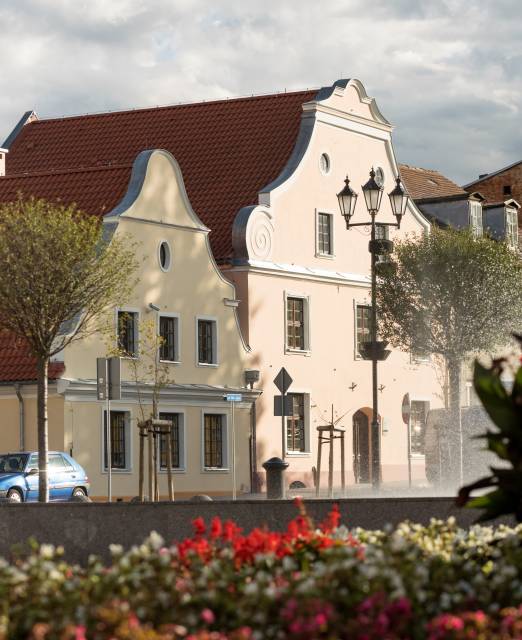The transformation that took place in the 19th century changed Włocławek completely. It grew from a small town to the largest center of eastern Kuyavia. In 1815 it had 2,444 inhabitants, and in 1914 the number of population reached 37,022.
In 1816 Ferdinand and Ludwig Bohm brothers established a chicory factory in Zazamcze, and in 1850 Wilhelm Haack set up an agricultural machinery factory. Another factory in the same branch was opened by Hugo Mühsam in 1883. In addition, other factories were established: Henrik Neuman's factory for physical instruments and apparatus in 1860, steam brickworks by Leon Bojańczyk in 1870; “Kühfeld, Czamanski, Szrejer and Boas” faience factory in 1873; “Danzyger, Hufnagel and Company” faience factory in 1880, Agricultural Machinery and Tools factory by I. Kochanowicz in 1886; “Keramos” faience works by A. Fibiger in 1894, C. Klauke’s wire products factory in 1895, “Nobiles” paints and varnishes by Mieczysław Sachnowski and Michał and Józef Kochanowicz in 1897 and cellulose works by the Cassirer brothers in 1898.
At the beginning of the 20th century, in addition to large factories, there were dozens of small industrial enterprises producing goods for the needs of the town's inhabitants and the whole region. In the 19th century, Włocławek changed its character from a town that was almost uniformly Polish in nationality and Catholic in religion, into a multi-national and multi-religious town. This was possible due to the influx of Germans, mostly Protestants, then Jews - followers of the Mosaic religion, and from 1815 the Russian Orthodox settlers.
The development of Włocławek, together with the change of its economic functions and the increase in population resulted in the modernization of the urban planning. According to the plan from 1818, the axis of the city was Nowa Street (3 Maja Street at present), which led from the Old Market Square to the newly marked square (Plac Wolności at present). Between 1848 and 1850 the following settlements were incorporated into the city: Syberia, Kępiny, Grondy, Papieżka, Glinki and Kolanowszczyzna. In 1851 the suburb of Zazamcze was included, too. Another expansion of Włocławek took place after the construction of the Warsaw-Bydgoszcz railway in 1862. Then, the neighboring villages of Łanieszczyzna, Bularka, Kokoszka, Rakutówek and Czerwonka were added.
The second half of the nineteenth and the beginning of the twentieth century brought the birth of Polish social organizations, active both in the cultural and national field: The Association of Volunteer Fire Brigades/in Polish: Stowarzyszenie Straży Ogniowej Ochotniczej we Włocławku /; The Włocławek Rowing Society/ in Polish: Włocławskie Towarzystwo Wioślarskie/; The Society of Christian Craftsmen and Polish Industrialists in Włocławek/ in Polish: Towarzystwo Chrześcijańskich Rzemieślników i Przemysłowców Polskich we Włocławku /; The Polish Gymnastic Society "Sokół" (Falcon) /in Polish: Polskie Towarzystwo Gimnastyczne „Sokół”/; The Polish Educational Society /in Polish: Polska Macierz Szkolna/ ; The Polish Tourist Society/ in Polish: Polskie Towarzystwo Krajoznawcze / and many others.
In 1905 the streets of Włocławek became the scene of strikes and mass demonstrations. Industrial workers and students protested against the political and social oppression of the Tsarist Russia authorities. On 7 February, workers from 16 factories went on strike and demonstrated in the streets, presenting numerous demands of social character. On the same day, students from the Włocławek Commercial School and young people from other schools joined the strike. They demanded education in Polish conducted by the Polish teachers. The wave of social unrest in the city lasted until mid-1907.
Political parties began to play an increasingly important role in the lives of the city's inhabitants. The most important were The Social Democratic Party of the Kingdom of Poland and Lithuania/ in Polish: Socjaldemokracja Królestwa Polskiego i Litwy and The Polish Socialist Party/ in Polish: Polska Partia Socjalistyczna /. The latter included the so-called Fighting Organisation, which was responsible for many assassinations of Russian officials and attacks on state institutions.



 Places
Places Guides
Guides Map
Map Outdoor games
Outdoor games Trails
Trails Events
Events Mobile app
Mobile app Contact
Contact


